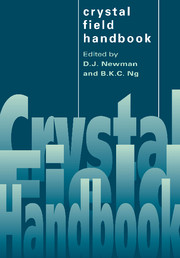Book contents
- Frontmatter
- Contents
- List of contributors
- Preface
- Introduction
- 1 Crystal field splitting mechanisms
- 2 Empirical crystal fields
- 3 Fitting crystal field parameters
- 4 Lanthanide and actinide optical spectra
- 5 Superposition model
- 6 Effects of electron correlation on crystal field splittings
- 7 Ground state splittings in S-state ions
- 8 Invariants and moments
- 9 Semiclassical model
- 10 Transition intensities
- Appendix 1 Point symmetry
- Appendix 2 QBASIC programs
- Appendix 3 Accessible program packages
- Appendix 4 Computer package CST
- Bibliography
- Index
Appendix 2 - QBASIC programs
Published online by Cambridge University Press: 10 December 2009
- Frontmatter
- Contents
- List of contributors
- Preface
- Introduction
- 1 Crystal field splitting mechanisms
- 2 Empirical crystal fields
- 3 Fitting crystal field parameters
- 4 Lanthanide and actinide optical spectra
- 5 Superposition model
- 6 Effects of electron correlation on crystal field splittings
- 7 Ground state splittings in S-state ions
- 8 Invariants and moments
- 9 Semiclassical model
- 10 Transition intensities
- Appendix 1 Point symmetry
- Appendix 2 QBASIC programs
- Appendix 3 Accessible program packages
- Appendix 4 Computer package CST
- Bibliography
- Index
Summary
This appendix describes the structure of the QBASIC programs and data files employed in the main text. In a few cases complete printouts of the programs have been provided for the reader's convenience. All programs and data files can be downloaded from the Cambridge University Press web site:
http://www.cup.cam.ac.uk/physics
or from the web site maintained by Dr M. F. Reid:
http://www.phys.canterbury.ac.nz/crystalfield
The QBASIC programs available from these sites are as follows.
(i) THREEJ.BAS, which calculates values of 3j symbols. Its use is described in Section 3.1.1. The subprogram, which forms the core of this program, is listed in Section A2.1.1.
(ii) REDMAT.BAS, which is used to determine J-basis reduced matrix elements of the tensor operators C(k) from LS-basis reduced matrix elements, such as those tabulated by Nielson and Koster [NK63]. The use of this program in calculating matrix elements is described in Section 3.1.1. It includes the subprogram SIXj, listed in Section A2.1.2.
(iii) ENGYLVL.BAS, which is used to calculate single J multiplet energy levels and eigenfunctions from crystal field parameters. This program is discussed at length in Chapter 3. A specific example of its use is given in Section 3.1.3.
(iv) ENGYFIT.BAS, which is used to fit crystal field parameters to sets of energy levels of a single J multiplet. This program is discussed at length in Chapter 3. A specific example of its use is given in Section 3.2.
(v) CORFACW.BAS, which determines combined coordination factors (Wybourne normalization) from input coordination angles. An example of the use of this program is given in Section 5.3.2.1.
[…]
Information
- Type
- Chapter
- Information
- Crystal Field Handbook , pp. 239 - 253Publisher: Cambridge University PressPrint publication year: 2000
